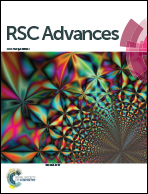Microwave plasma-assisted silicon nanoparticles: cytotoxic, molecular, and numerical responses against cancer cells
Abstract
Silicon nanoparticles (SiNPs), which have a special place in material science due to their strong luminescent property and wide applicability in various physicochemical arenas, such as solar cells and LEDs, were synthesised by a microwave plasma-assisted process using an argon–silane mixture. Several characterization tools were applied to check the crystallinity (XRD) and morphological (FESEM, TEM, ∼20 ± 2 nm size) and topographical (AFM, ∼20 nm) details of the NPs. The high-purity SiNPs were applied on myoblast cancer cells to investigate the reactivity of the NPs at different doses (200, 1000 and 2000 ng mL−1) for different incubation periods (24 h, 48 h & 72 h). The MTT assay was utilized to determine the percentage of viable and non-viable cells, while the cell organization was observed via microscopy and CLSM. Additionally, the molecular responses (RT-PCR), such as apoptosis, were analyzed in presence of caspase 3 and 7, and the results showed an upregulation with SiNPs. To validate the obtained data, analytical studies were also performed for the SiNPs via statistical analysis and the most reliable data values were evaluated and acceptable as per the ICH guidelines.



 Please wait while we load your content...
Please wait while we load your content...